Notebook - February 23, 2000
University ban on Nude Olympics
keeps most sophomores clothed
One streaker runs despite prohibition
Extremism in the defense of nudity is no vice, a lone competitor in this
year's Nude Olympics might have shouted as he raced across Princeton's snow-covered
campus shortly after midnight on Friday, January 20.
The other students who remained on campus the last Friday before intersession
exercised some moderation. Facing a year's suspension for any activity resurrecting
the Nude Olympics, which President Shapiro and the trustees banned last
year, Princeton undergraduates surrendered their 20-year tradition for a
fairly typical night on Prospect Avenue.
The last Nude Olympics, which took place January 8, 1999, proved to be
a raucous event in which six undergraduates were hospitalized for alcohol
poisoning and four intoxicated students were taken to McCosh Health Center.
In addition there were shocking reports of lewd behavior in Holder Courtyard,
the traditional site of the games. Shapiro and university administrators
moved quickly to quell the event. In a statement printed in the January
13, 1999, Daily Princetonian, Shapiro said, "I believe we can no longer
tolerate the risks that it has come to pose to our students. I am simply
not willing to wait until a student dies before taking preventive action."
Ten days later, the trustees endorsed Shapiro's ban.
This year, with university administrators vowing to enforce discipline
on Prospect Avenue as well as on campus, a few Street-goers-no more than
usual-staggered around the clubs shirtless or stripped down to underwear.
The lone streaker on campus was neither apprehended nor identified, said
university spokesman Justin Harmon '78.
As snow began to fall Thursday night, the proctors mustered in Holder
Court. Staff from each of the five residential colleges patrolled their
own courtyards until after midnight, and Princeton Borough police officers
remained on hand to provide assistance.
A few students tossed snowballs in Holder, but most sought refuge on
the Street. One student at Cloister Inn marked his bare chest with the words:
"C'mon, Hal. Suspend me." But he hardly gave President Shapiro
a chance. He was wearing pants.
As the second semester begins, the sophomore class continues its search
for an official, university-sanctioned class event. Administrators have
nixed several suggestions on grounds of bad taste or state law, and students
themselves voted down an idea to burn former Dean of Student Life Janina
Montero in effigy. Other rejected proposals have included an outdoor food
fight, a large-scale snowball war, and a tropical beach party. n
-Jeremy Weissman '01
Undergraduates teach chemistry
in local schools
Anyone who has ever yawned through a science class will snap to attention
when members of Princeton's Chemistry Outreach Program turn up for a demonstration.
Eyes widen when a half-cup of cream, sugar, and vanilla transforms into
ice cream with the help of liquid nitrogen, and when cabbage juice switches
colors thanks to such humble ingredients as vinegar or baking soda.
"I tell people it's not magic because I can explain it-it's chemistry,"
said Dave Tang '00. "We give them a taste for science so they want
to learn more."
Tang and 20 others, mostly junior and senior chemistry majors, are part
of the three-year-old program. They volunteer to visit elementary classrooms,
staff events at Frick Lab, participate in community science programs, or
offer teacher workshops-all in the name of making chemistry relevant and
interesting. Chemistry Professor Warren S. Warren, an initiator of the Outreach
Program, estimates that more than a thousand kindergarten through 12th grade
students in the area see science in action yearly, largely through this
departmental effort.
"It's a lot of fun, that's the major reason students sign up,"
said Kathryn Wagner, the program's director. But it also gives students
a chance to hone their communication skills. "My involvement in the
program will definitely help me in the future when I give research and business
presentations," said Wilton Virgo '00. Future doctors Laura Jawidzik
'00 and Hanna Glomska '01 said they've gotten practice explaining complicated
subjects in terms nonscientists can follow.
For years university professors gave science demonstrations to local
groups when invited; the outreach program formalizes the university's community
involvement, according to Wagner. Program participants learn a repertoire
of a dozen experiments that they gear in complexity to their audience's
sophistication. Messy experiments-making a variation of Silly Putty with
white glue and borax or concocting cornstarch glue-rank with the liquid
nitrogen ones as most popular. Students spend 18 hours or more in safety
training, setting up materials for demonstrations, supervising activities,
and personally leading at least one public presentation to earn a program
certificate. In 1999, the first year certificates were offered, six seniors
qualified.
While having fun and polishing communication skills, Outreach Program
participants are also energizing the next generation of scientists. "It's
important for young people to realize how important science is to everyday
life," said Aparna Kesarwala '00. After presenting the ice cream demonstration
at a Frick Lab tour, Kesarwala received what might be a compliment for the
whole Outreach Program from a high schooler: "You know, chemistry is
cool."
-Maria LoBiondo
Earning the big bucks
Going to an academically elite college like Princeton doesn't necessarily
boost your earnings potential over someone who attended a less elite college,
according to a study by Bendheim Professor of Economics and Public Affairs
Alan B. Krueger. Ambition is a better indicator of future income. In his
paper "Estimating the Payoff to Attending a More Selective College,"
coauthored with researcher Stacy Berg Dale *96 of the Andrew W. Mellon Foundation
and published by the National Bureau of Economic Research, a school's selectivity,
as measured by matriculants' average SAT scores, does not correlate with
students' later income, once the abilities of the students upon entering
college are taken into account. This finding challenges previous studies
positively linking earnings to a college's prestige.
Krueger and Dale not only looked at the schools that students attended
but also where they were accepted and rejected. They found that where a
student applies is a more powerful predictor of future income than where
he or she attends. "Student ambition, as reflected in the quality of
the school to which he or she applies, is a better predictor of earning
success than what college they ultimately choose or which college chooses
them," said Krueger. The researchers did find, however, that for a
subset of students-those from a financially disadvantaged background-an
elite education did bring greater financial rewards.
Test-tube computer
Princeton researchers have developed a computer that uses the biological
molecule RNA to solve complex problems. The achievement marks a significant
advance in molecular computing, an emerging field in which scientists are
harnessing molecules such as DNA and RNA to solve certain problems. In work
published February 15 in the Proceedings of the National Academy of Sciences,
the scientists used a test tube containing 1,024 different strands of RNA
to solve a simple version of the "knight problem," a chess puzzle
that is representative of a class of problems that requires brute-force
computing.
This test-tube computer does not have any immediate applications, and
it will probably never completely replace silicon technology. But it does
have attractive aspects, said Assistant Professor of Ecology and Evolutionary
Biology Laura F. Landweber '89, who led the research project in collaboration
with Professor of Computer Science Richard J. Lipton, postdoctoral fellow
Dirk Faulhammer, and Anthony R. Cukras '98. DNA and RNA can store much more
data in a given space than conventional memory chips. And with vast numbers
of genetic fragments floating in a test tube, a biomolecular computer could
perform thousands or millions of calculations at the same time.
In Brief
New Forbes Master
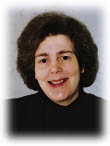 Forbes College will get a new Master of the House on July 1, when Professor
of Computer Science Andrea S. La Paugh takes over from John G. Gager, Jr.,
the William H. Danforth Professor of Religion, who has held the post since
1992. La Paugh, who earned a Ph.D. in computer science in 1980 from MIT,
joined the Princeton faculty in 1981. A specialist in computer-aided design
(CAD) of digital systems, La Paugh has worked extensively in the development
of algorithms for problems in digital design. Currently associate chair
of the computer science department, La Paugh is a member of the Faculty
Committee on Examinations and Standing, among other committees. She has
served for many years as a freshman adviser in the School of Engineering.
Now a faculty fellow at Butler College, she was a fellow at Forbes from
1983 to 1992.
Forbes College will get a new Master of the House on July 1, when Professor
of Computer Science Andrea S. La Paugh takes over from John G. Gager, Jr.,
the William H. Danforth Professor of Religion, who has held the post since
1992. La Paugh, who earned a Ph.D. in computer science in 1980 from MIT,
joined the Princeton faculty in 1981. A specialist in computer-aided design
(CAD) of digital systems, La Paugh has worked extensively in the development
of algorithms for problems in digital design. Currently associate chair
of the computer science department, La Paugh is a member of the Faculty
Committee on Examinations and Standing, among other committees. She has
served for many years as a freshman adviser in the School of Engineering.
Now a faculty fellow at Butler College, she was a fellow at Forbes from
1983 to 1992.
Humanities Award
Civil War historian James M. McPherson has been named the 2000 Jefferson
Lecturer for the Humanities by the National Endowment for the Humanities-the
highest honor bestowed by the federal government for achievement in humanities.
McPherson, the George Henry Davis '86 Professor of American History, will
present a public lecture, "For a Vast Future Also: Lincoln and the
Millennium" on March 27 at the John F. Kennedy Center for the Performing
Arts in Washington. McPherson, who has taught at Princeton since 1962, received
a Pulitzer Prize in 1989 for Battle Cry of Freedom: The Civil War Era and
the Lincoln Prize in 1998 for his For Cause and Comrades: Why Men Fought
in the Civil War.
Sachs scholar
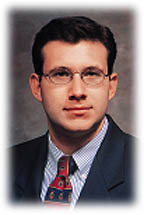 Kenneth L. Shaitelman '00 has been named the 31st recipient of the Daniel
M. Sach's '60 Scholarship, which will provide two years of study at Oxford
University. A classics major who will also receive certificates in the Woodrow
Wilson School and in Russian language and culture, he will work toward an
M.Phil. in Russian and East European studies. When he's not hitting the
books, Shaitelman plays the violin in the Princeton University Orchestra.
Kenneth L. Shaitelman '00 has been named the 31st recipient of the Daniel
M. Sach's '60 Scholarship, which will provide two years of study at Oxford
University. A classics major who will also receive certificates in the Woodrow
Wilson School and in Russian language and culture, he will work toward an
M.Phil. in Russian and East European studies. When he's not hitting the
books, Shaitelman plays the violin in the Princeton University Orchestra.
University to sell 80 acres
Princeton has entered into a contract to sell property at the Princeton
Forrestal Center in Plainsboro, New Jersey-80 acres of land along Route
1-to a Houston developer, Patrinely Group L.C.C. The land will be sold in
stages over the next five to seven years. The first parcel was sold last
October. When all the property has changed hands, the university will have
received about $30 million, said Richard R. Spies *72, vice-president for
finance and administration. Princeton acquired most of the land in the 1950s
as part of the original purchase of the Forrestal campus. In the 1970s the
university decided to commercially develop the property adjacent to the
campus. Currently, nothing stands on the 80 acres except the beginnings
of the developer's first building.
Mixing sports and math on the Web
for an ESPN.com column
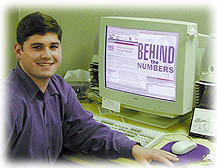 Many students who enter the Department of Operations Research and Financial
Engineering dream of jobs on Wall Street or careers as financial consultants
to the world's top corporations. But one graduate who studied probability
and statistics at Princeton has put his knowledge of mathematics and optimization
to an unusual use. Jonathan W. Sills '96 has been writing a regular column
for ESPN.com for two years. In each column, titled "Behind the Numbers,"
Sills uses his engineering education to look at the numbers behind sports.
Many students who enter the Department of Operations Research and Financial
Engineering dream of jobs on Wall Street or careers as financial consultants
to the world's top corporations. But one graduate who studied probability
and statistics at Princeton has put his knowledge of mathematics and optimization
to an unusual use. Jonathan W. Sills '96 has been writing a regular column
for ESPN.com for two years. In each column, titled "Behind the Numbers,"
Sills uses his engineering education to look at the numbers behind sports.
"Mathematics is about certainties," he said. "We love
sports for its uncertainties. I try to point out what happens when the exact
calculations of mathematics meet the human, unpredictable factors that make
sports so entertaining. There is an immense emotional aspect to sports,
and I try to discuss the issues logically."
"Behind the Numbers" covers such topics as "How tough
is Q-School?," which analyzes a golfer's long-term chances of earning
and retaining a spot on the PGA tour; "Can math give hockey scheduling
an assist?," which discusses the complications of sports scheduling;
and "What does average salary mean in the NBA?," which examines
the distribution of the NBA's payroll.
Sills takes each issue at hand and discusses it in mathematical terms.
He proposes variables, discusses components, and analyzes resulting equations.
"Behind the Numbers" is a sideline occupation for Sills, who
is vice-president of strategy and product development for ProFlowers.com,
an enterprise founded by Jared P. Schutz '96 that sells fresh flowers over
the Internet.
"People with an analytical background and an interest in sports
have found my column really refreshing," Sills says. "Not many
sportswriters are into the Law of Cosines or Markov Chains. I have gotten
thousands of letters. A lot of people are tickled that someone is bringing
a mathematical perspective to sports."
This story was adapted from one by Ann Haver-Allen that appeared in the
fall 1999 E-Quad News.
"Behind the Numbers" can be found at: http://espn.go.com/moresports/sillsarchive.html.
Bill McCleery . . . Peter Lewis
'55 . . . textbooks online
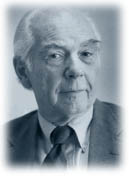 When William McCleery (right) died January 16, paw and Princeton lost
a good friend. Bill, who was 88 when he died, was among many things a playwright,
a theater reviewer, and longtime editor of University magazine, a quarterly
that published Princeton-related articles of general interest. He was also
a frequent contributor to paw. A sociable man, Bill disarmed many people
with his wit and charm and gentle smile. Through the years children devoured
Wolf Story, Bill's children's tale first published in 1947 and still in
print. At Bill's memorial service, held in the Chapel on January 22, several
people spoke, including Bob Durkee '69, vice-president for public affairs,
who noted in his eulogy: "Bill wrote in many genres, but one of which
he was clearly the master was the conversation. You knew you were approaching
the end of the article when he wrote 'As we got up from the table.' What
would follow would be one final pithy comment, from him or from the subject,
as a kind of benediction. Well, Bill, as we get up from the table today,
our hearts are full of your words, your kindnesses, your unfailing grace.
We hope that your spirit is already creating dialogue in this world as we
give undying thanks for your days among us." And we at paw, too, say
thanks for everything.
When William McCleery (right) died January 16, paw and Princeton lost
a good friend. Bill, who was 88 when he died, was among many things a playwright,
a theater reviewer, and longtime editor of University magazine, a quarterly
that published Princeton-related articles of general interest. He was also
a frequent contributor to paw. A sociable man, Bill disarmed many people
with his wit and charm and gentle smile. Through the years children devoured
Wolf Story, Bill's children's tale first published in 1947 and still in
print. At Bill's memorial service, held in the Chapel on January 22, several
people spoke, including Bob Durkee '69, vice-president for public affairs,
who noted in his eulogy: "Bill wrote in many genres, but one of which
he was clearly the master was the conversation. You knew you were approaching
the end of the article when he wrote 'As we got up from the table.' What
would follow would be one final pithy comment, from him or from the subject,
as a kind of benediction. Well, Bill, as we get up from the table today,
our hearts are full of your words, your kindnesses, your unfailing grace.
We hope that your spirit is already creating dialogue in this world as we
give undying thanks for your days among us." And we at paw, too, say
thanks for everything.
On January 5 Trustee Peter Lewis '55 was arrested at the Auckland, New
Zealand, airport and later charged with possession of more than three ounces
of marijuana and marijuana resin. Lewis, CEO of the Progressive Corporation,
an automobile insurance company headquartered in Cleveland, Ohio, recently
donated $55 million to the university, $35 million of it to be used for
the new Institute for Integrative Genomics. In New Zealand, according to
a January 8 article in the Cleveland Plain Dealer, Lewis "appeared
Friday (Thursday in the United States) in the Otahuhu District Court, according
to a source in Auckland. The source said Lewis made an unspecified contribution
to an Auckland drug rehabilitation center, and the charges against him were
'discharged without conviction.' " The Plain Dealer also reported that
Lewis, who holds an estimated $600 million worth of his company's stock,
in 1998 was "one of three financial backers of an estimated $5 million
advertising campaign urging voters in five states to legalize the medical
use of marijuana."
Adding to its dot-com business, the University Store last month began
selling textbooks and course materials online. Already a presence on the
Web, the store's venture into textbooks was bound to happen. James Sykes,
the U-Store's president, told the Prince, "Almost all of the students
and professors are wired, so it was only natural for us to have this service
available to them."
To Our Readers
Committee recommends new governing structure for PAW
A special committee convened to review the future of the Princeton Alumni
Weekly has recommended a new governing structure for it, largely to give
financial relief to classes and to provide the magazine with an institutional
home. Under the proposal, paw's current parent organization, Princeton Alumni
Publications, Inc. (PAP), would be dissolved, and the magazine would come
under the administrative umbrella of the Alumni Council. For editorial direction,
long-term planning, and budgeting, however, the editor would report to an
11-member board similar in composition to paw's current 14-member board.
The editor would retain sole responsibility for the editorial content
of the magazine. Paw's proposed charter emphasizes its historic editorial
independence, citing it as a defining characteristic. Under the charter
"the editor has final authority to determine what is published in the
magazine and how it is presented, except with respect to the President's
Pages." Reflecting language that has appeared on its masthead since
the 1920s, paw would continue "to record news of the alumni and to
review without partiality the achievements and problems of the administration,
faculty, and student body of the university."
The committee also recommended that the university more than double its
financial contribution to paw to provide relief to the alumni classes, whose
dues now pay for just over half the magazine's $1.3 million annual budget.
Currently, the university grants paw a subsidy amounting to about 10 percent
of the budget. Under the proposed arrangement, the university and the classes
would contribute equal amounts to paw. Their total contribution would cover
about two-thirds of the budget, with most of the remaining third covered
by advertising revenues. Currently, a third of the budget is covered by
advertising.
The review committee included representatives from the PAP board, the
Alumni Council, the university's Board of Trustees, and the administration.
It was chaired by Brent L. Henry '69, a university trustee and immediate
past chair of the Alumni Council.
The proposed charter must be approved by the executive committee of the
Alumni Council and the board of PAP. Both will vote on the matter at meetings
in April.
Under the proposed structure, responsibility for hiring and firing the
editor, and for annual performance review and goal setting, will be exercised
by a three-member management committee composed of the chair and vice-chair
of the paw board, who must be alumni with professional experience in the
editorial side of journalism, and the director of the Alumni Council.
If the charter is adopted as drafted, the 11-member board will include
three alumni with professional experience in the editorial side of journalism,
two alumni with professional experience in publishing, one graduate alumnus
or alumna with professional experience in journalism or publishing, and
a member of the faculty. They will all serve staggered three-year terms.
The other four members are ex-officio: the vice-chair of the Alumni Council,
the chair of the Alumni Council Committee on Class Affairs, the vice-president
for public affairs, and the director of the Alumni Council.
The review committee recommended that the new board reflect the diversity
of the alumni body with respect to age, type of degree, gender, and ethnicity.
It also called for a review of the magazine's frequency-it currently publishes
17 issues a year-with an understanding that some reduction could be put
in place beginning this fall to permit greater attention to the quality
of each issue.
In recent years many classes have found it increasingly difficult to
pay their paw bills, which often amount to nearly 100 percent of their budgets.
Because all alumni receive the magazine, class members who pay their dues
end up carrying members who don't pay theirs. According to those involved
in the review, the proposed changes in the magazine's structure go part
and parcel with the proposed changes in its financing-the university was
willing to assist the classes by contributing a significantly larger share
to paw's budget so long as it had more say in how the magazine is governed.
At the same time, administrators recognize the importance of paw's editorial
independence and have agreed to a charter that effectively proscribes their
interference in editorial decisions.
As chair of the review committee, Henry noted that paw "is the principal
means of communication among alumni, and between alumni and the university.
We care deeply about preserving its editorial independence, about providing
a central role for alumni in overseeing its operations, about enhancing
its quality, and about its effectiveness in conveying to its readers as
complete, accurate, and perceptive an understanding as possible of the university
and the alumni. We believe we can best achieve these objectives by vesting
responsibility for the magazine in the representative body for all alumni,
the Alumni Council, and that the magazine will also benefit administratively
and financially from its access to the administrative resources of the university."
Said Peter G. Brown '70, the chair of PAP's executive committee, "It's
become increasingly apparent in recent years that the magazine can't keep
hiking up the cost to the classes. We think the proposed structure is a
reasonable solution to this problem. All of us on PAP's board who have also
been part of the review committee are confident the new arrangement will
have no effect on the editor's ability to stay true to paw's long tradition
of being the alumni's magazine about the university-not the university's
magazine for alumni." The new administrative arrangement ensures editorial
independence, said Brown, through its management structure, terms of office
for board members, nominating process, and amending process to the charter.
The magazine was founded in April 1900 by alumni as a way to stay in
touch with Princeton and each other. The Princeton University Press was
established in large part to print paw, which remained under its aegis from
1906 to 1991, when PAP was incorporated as a nonprofit corporation. In 1916
the press established a five-member Board of Editorial Direction, and that
same year, the alumni classes agreed to purchase subscriptions for all their
members, a system that has been in place ever since.
The Daily Princetonian voiced concern over paw's proposed restructuring.
In an editorial, the paper warned the university to respect the magazine's
integrity: "The university's announcement that the Alumni Council will
assume administrative responsibility for the publication raises doubts as
to whether that independence can continue. Though it is unclear exactly
what role the university will play, this type of relationship can lead to
an editorial bias, or at least an appearance of one. . . . It is necessary
that the university recognize the benefit of allowing the publication to
maintain complete editorial independence."
Brown agreed that paw has to continue covering "scandals at the
top with bulldog reporting and editing. We can't shy away from these things."
It would not serve the alumni to publish "puff pieces," he said.
Readers are invited to respond to Brent Henry c/o The Alumni Council,
PO Box 291, Princeton, NJ 08544 or to paw for possible publication. For
the text of the proposal, please see www.princeton.edu/~paw.
Members of the special Paw review committee:
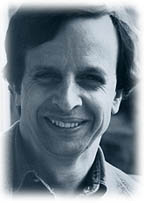 Peter G. Brown '70 (right), Chair of paw's editorial committee and paw's
board of trustees
Peter G. Brown '70 (right), Chair of paw's editorial committee and paw's
board of trustees
Janet Clarke '75 , Chair of the trustee committee on university resources
Diane deCordova '83 , Vice-chair of the Alumni Council
Robert K. Durkee '69, Vice-president for public affairs
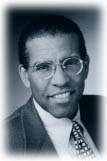 Brent L. Henry '69 (left), Chair of the special paw review committee,
university trustee, and former chair of the Alumni Council
Brent L. Henry '69 (left), Chair of the special paw review committee,
university trustee, and former chair of the Alumni Council
Landon Y. Jones '66 , Vice-chair of paw's editorial committee
Sara Love '89 , Chair of the class affairs committee of the Alumni Council
Anthony D. Lutkus *74 , Past president, Association of Princeton Graduate
Alumni
Karen Magee '83 , Chair, trustee committee on information technology
and former chair, paw publications committee
Luther T. Munford '71 , Former chair of the Alumni Council
Nancy J. Newman '78 , Chair of the trustee committee on alumni affairs
Cynthia Penney '83 , Former member of paw's editorial committee
Sarah E. Thornton '80 , Chair of paw's publications committee
Joseph L. Serafini '64 , Chair of the Alumni Council
Kathryn M. Taylor '74 , Director of the Alumni Council
GO TO
the Table of Contents of the current issue
GO TO
PAW's home page
paw@princeton.edu
 Forbes College will get a new Master of the House on July 1, when Professor
of Computer Science Andrea S. La Paugh takes over from John G. Gager, Jr.,
the William H. Danforth Professor of Religion, who has held the post since
1992. La Paugh, who earned a Ph.D. in computer science in 1980 from MIT,
joined the Princeton faculty in 1981. A specialist in computer-aided design
(CAD) of digital systems, La Paugh has worked extensively in the development
of algorithms for problems in digital design. Currently associate chair
of the computer science department, La Paugh is a member of the Faculty
Committee on Examinations and Standing, among other committees. She has
served for many years as a freshman adviser in the School of Engineering.
Now a faculty fellow at Butler College, she was a fellow at Forbes from
1983 to 1992.
Forbes College will get a new Master of the House on July 1, when Professor
of Computer Science Andrea S. La Paugh takes over from John G. Gager, Jr.,
the William H. Danforth Professor of Religion, who has held the post since
1992. La Paugh, who earned a Ph.D. in computer science in 1980 from MIT,
joined the Princeton faculty in 1981. A specialist in computer-aided design
(CAD) of digital systems, La Paugh has worked extensively in the development
of algorithms for problems in digital design. Currently associate chair
of the computer science department, La Paugh is a member of the Faculty
Committee on Examinations and Standing, among other committees. She has
served for many years as a freshman adviser in the School of Engineering.
Now a faculty fellow at Butler College, she was a fellow at Forbes from
1983 to 1992. Kenneth L. Shaitelman '00 has been named the 31st recipient of the Daniel
M. Sach's '60 Scholarship, which will provide two years of study at Oxford
University. A classics major who will also receive certificates in the Woodrow
Wilson School and in Russian language and culture, he will work toward an
M.Phil. in Russian and East European studies. When he's not hitting the
books, Shaitelman plays the violin in the Princeton University Orchestra.
Kenneth L. Shaitelman '00 has been named the 31st recipient of the Daniel
M. Sach's '60 Scholarship, which will provide two years of study at Oxford
University. A classics major who will also receive certificates in the Woodrow
Wilson School and in Russian language and culture, he will work toward an
M.Phil. in Russian and East European studies. When he's not hitting the
books, Shaitelman plays the violin in the Princeton University Orchestra. Many students who enter the Department of Operations Research and Financial
Engineering dream of jobs on Wall Street or careers as financial consultants
to the world's top corporations. But one graduate who studied probability
and statistics at Princeton has put his knowledge of mathematics and optimization
to an unusual use. Jonathan W. Sills '96 has been writing a regular column
for ESPN.com for two years. In each column, titled "Behind the Numbers,"
Sills uses his engineering education to look at the numbers behind sports.
Many students who enter the Department of Operations Research and Financial
Engineering dream of jobs on Wall Street or careers as financial consultants
to the world's top corporations. But one graduate who studied probability
and statistics at Princeton has put his knowledge of mathematics and optimization
to an unusual use. Jonathan W. Sills '96 has been writing a regular column
for ESPN.com for two years. In each column, titled "Behind the Numbers,"
Sills uses his engineering education to look at the numbers behind sports. When William McCleery (right) died January 16, paw and Princeton lost
a good friend. Bill, who was 88 when he died, was among many things a playwright,
a theater reviewer, and longtime editor of University magazine, a quarterly
that published Princeton-related articles of general interest. He was also
a frequent contributor to paw. A sociable man, Bill disarmed many people
with his wit and charm and gentle smile. Through the years children devoured
Wolf Story, Bill's children's tale first published in 1947 and still in
print. At Bill's memorial service, held in the Chapel on January 22, several
people spoke, including Bob Durkee '69, vice-president for public affairs,
who noted in his eulogy: "Bill wrote in many genres, but one of which
he was clearly the master was the conversation. You knew you were approaching
the end of the article when he wrote 'As we got up from the table.' What
would follow would be one final pithy comment, from him or from the subject,
as a kind of benediction. Well, Bill, as we get up from the table today,
our hearts are full of your words, your kindnesses, your unfailing grace.
We hope that your spirit is already creating dialogue in this world as we
give undying thanks for your days among us." And we at paw, too, say
thanks for everything.
When William McCleery (right) died January 16, paw and Princeton lost
a good friend. Bill, who was 88 when he died, was among many things a playwright,
a theater reviewer, and longtime editor of University magazine, a quarterly
that published Princeton-related articles of general interest. He was also
a frequent contributor to paw. A sociable man, Bill disarmed many people
with his wit and charm and gentle smile. Through the years children devoured
Wolf Story, Bill's children's tale first published in 1947 and still in
print. At Bill's memorial service, held in the Chapel on January 22, several
people spoke, including Bob Durkee '69, vice-president for public affairs,
who noted in his eulogy: "Bill wrote in many genres, but one of which
he was clearly the master was the conversation. You knew you were approaching
the end of the article when he wrote 'As we got up from the table.' What
would follow would be one final pithy comment, from him or from the subject,
as a kind of benediction. Well, Bill, as we get up from the table today,
our hearts are full of your words, your kindnesses, your unfailing grace.
We hope that your spirit is already creating dialogue in this world as we
give undying thanks for your days among us." And we at paw, too, say
thanks for everything. Peter G. Brown '70 (right), Chair of paw's editorial committee and paw's
board of trustees
Peter G. Brown '70 (right), Chair of paw's editorial committee and paw's
board of trustees Brent L. Henry '69 (left), Chair of the special paw review committee,
university trustee, and former chair of the Alumni Council
Brent L. Henry '69 (left), Chair of the special paw review committee,
university trustee, and former chair of the Alumni Council